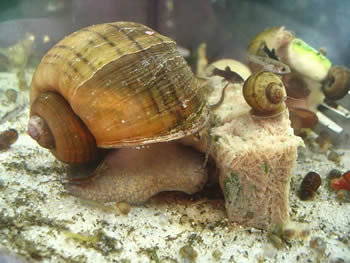Apple Snail – Mystery Snail
By fishaliciousFamily: Ampullariidae
Several Mystery Snail Genera & Distribution:
Asolene, Felipponea, Marisa, and Pomacea are from South AmericaThe genera Afropomus, Lanistes, and Saulea are found in Africa
The genus Pila is native to both Africa and Asia
The biggest freshwater snails in the world are given a closer look here. When properly cared for they can easily reach 15cm / 6 inches. They are not fussy when it comes to water parameters although care should be taken in low alkaline water. Temp: 18 - 28°C / 65 – 82F
Some of the most popular Mystery Snails:
Pomacea bridgesii are the most commonly found and kept in our aquariums – they come in all colors of the rainbow and do not eat plants.
Pomacea canaliculata is also often found unfortunately these do eat aquatic plants they are more round than the bridgesii. These are also available in many different colors.
Marisa cornuarietis also known as the Giant Ramshorn Snail are also very popular in the aquarium trade but do not actually belong to the apple snail family they are however very often sold as apple snails in shops.
Pomacea paludosa also known as the Florida Apple Snail can also be purchased and are usually collected from ponds & ditches in Florida.
 Apple Snail - picture by nanaglen2001 |
Feeding Mystery Snails
They are true scavengers and will clean up anything left over from feeding the fish as well as algae. All of them will also eat your aquatic plants with the exception of the Pomacea bridgesii.Breeding Mystery Snails
They are not hermaphroditic like most snails so a male & female are needed for breeding. It is impossible to sex them until breeding actually takes place. High temperatures and plenty of food will stimulate them to breed. Pomacea, Pila and Asolene/Pomella will all deposit their eggs above the waterline to keep the eggs safe from fish. The eggs are big calcareous clutches which stay above the waterline for around 2-4 weeks depending on the temperature, the little snails will hatch and drop into the water.

Apple snail - picture by nanaglen2001

picture by nanaglen2001
Related Articles
Amano shrimp- Information about Amano shrimp
Amano Algae Eating Shrimp - An article about the algae eating Amano shrimp
Aquarium crabs - A guide to aquarium crabs
Black Mystery Snail - An introduction to the Black Mystery Snail
Breeding Crayfish - basics too crayfish breeding
Breeding of Red Clawed Mangrove Crabs - How to breed red clawed crabs
Freshwater shrimp - Information about Freshwater shrimp
Ghost shrimp - Information about Ghost shrimp
Malaysian Rainbow Shrimp - Information on how to keep and breed this shrimp species.
Red Cherry Shrimp - A guide to this Algae eating shrimp.
Red clawed lobsters - A short overview of red claw lobsters (crayfish)
Red Nosed Shrimp - information on keeping this shrimp in aquarium.
Snails: Friend or Foe in the Aquarium? - The biology of snails. Their advantages and disadvantages in an aquarium. How to keep them in check.
